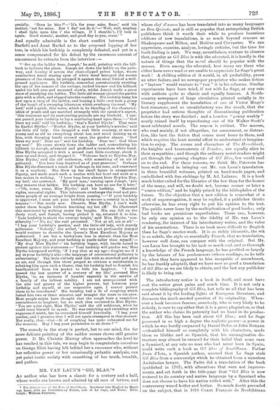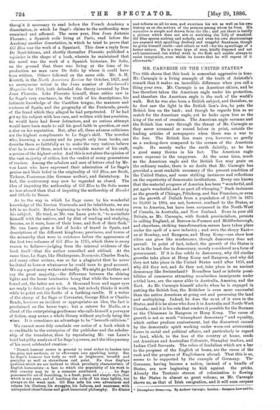MR. VAN LATTN'S " GIL BLA.S."* AN author who has
been a classic for a century and a half, whose works are known and admired by all men of letters, and
* The Adrent”res of Gil B'as of Santillana. Rendered into English by Henri van Lana, with an lntroductoy Notice, Life of Le Sage, and Notes. Edin- burgh: William Paterson.
whose chef d'ouvre has been translated into as many languages as Don Quixote, and is still so popular that enterprising British publishers think it worth their while to produce luxurious editions of new translations, is as much beyond censure as Shakespeare and Milton, and Moliere and Cervantes. We can appreciate, examine, analyse, lovingly criticise, but the time for fault-finding is past. We may, nevertheless, venture to observe that, popular as Gil Bias is with the educated, it is hardly in the nature of things that the novel should be popular with the masses. Even among the educated, how many are there who either have never read or are unable to appreciate Le Sage's great work ! A shilling edition of it would, in all probability, prove an utter failure, and no newspaper proprietor who makes fiction a " feature " would venture to " run " it in his columns. Similar experiments have been tried, if not with Le Sage, at any rate with authors quite as classic and equally famous. A North- country newspaper of large circulation printed serially in its literary supplement the translation of one of Victor Hugo's best romances, and so unsatisfactory was the result, that the proprietor had serious thoughts of discontinuing publication before the story was finished ; and a London "penny weekly" nearly ruined itself by reproducing one of Sir Walter Scott's most celebrated novels. The reason is evident. The masses, who read mainly, if not altogether, for amusement., or distrac- tion, like best the fiction that comes most home to them, and which requires the least mental effort to understand or imagina- tion to enjoy. The scenes and characters of The Hunchback, the knights and tournaments of Ivanhoe, are equally alien to their sympathies ; and though the ordinary novel-readers might get through the opening chapters of Gil Bias, few would read on to the end. For these reasons, we think Mr. Paterson has been well advised in bringing out Mr. van Latin's translation in three beautiful volumes, printed on hand-made paper, and embellished with fine etchings by M. Ad. Lalauze. It is a book much better suited for the libraries of the few than for the homes of the many, and will, we doubt not, become sooner or later a "scarce edition," and be highly prized by the bibliophiles of the future. To the objection that a new edition is somewhat of a work of supererogation, it may be replied, if a publisher thinks otherwise, he has every right to put his opinion to the test. The public never loses by the multiplication of good books ; only bad books are pernicious superfluities. There can, however, be only one opinion as to the fidelity of Mr. van Laun's rendering, the interest of his introductory notice, and the value of his annotations. There is no book more difficult to English than Le Sage's master-work. It is so richly idiomatic, the wit is so subtle, the style so essentially French, that no translation, however well done, can compare with the original. But Mr. van Laun has brought to his task so much zeal, and so thorough a knowledge of the French language, he has profited so largely by the labours of his predecessors (whose readings, as he tells us, when they have appeared to him incapable of amendment, he has frankly adopted), that we have now as good a translation of Gil Bias as we are likely to obtain, and the last any publisher is likely to bring out.
The introductory notice is a book in itself, and must have cost the writer great pains and much time. It is not only a complete bibliography of Gil Bias, but tells us all that has been said about it by the leading lights of European literature, and discusses the much mooted question of its originality. When- ever a book becomes famous, somebody, who is very likely to be nobody, is sure to say either that it is a gross plagiarism, or that the author who claims its paternity had no hand in its produc- tion. All this has been said about Gil Bias ; and Le Sage possessed in so high a degree the realistic power—a power in which he was hardly surpassed by Daniel Defoe or John Bunyan —identified himself so completely with his characters, made them so lifelike and so Spanish, that his unimaginative de- tractors may almost be excused for their belief that none save a Spaniard, at any rate no man who had never been in Spain, could write such a book as Gil Dias of Santillana. Father Juan d'Ista, a Spanish author, averred that Le Sage stole Gil Bias from a manuscript which he obtained from a nameless Andalusian lawyer. The Padre did a translation of the book (published in 1787), with alterations that were not improve- ments, and set forth in the title-page that "Gil Bias is now restored to its country and native language by a Spaniard who does not choose to have his nation trifled with." After this the controversy waxed hotter and hotter. So much doubt prevailed on the subject, that in 1818 Count Francois de Neufchitean
thouglit it necessary to read before the French Academy a dissertation, in which Le Sage's claims to the authorship were examined and affirmed. The same year, Don Juan Antonio Florento, a Spanish exile living at Paris, read before the Academy another dissertation, in which he tried to prove that Gil Bias was the work of a Spaniard. This drew a reply from De Neufchiteau, and shortly thereafter Florento published a rejoinder in the shape of a book, wherein he maintained that the novel was the work of a Spanish historian, De Solis, on the ground that there was living at the time of its production no man save De Solis by whom it could have been written. Others followed on the same side. Mr. A. H. Everett, in the North American Review for October, 1827, and an anonymous writer in the June number of Blackwood's Magazine for 1844, both defended the theory invented by Don Juan Florento. Like Florento himself, these critics saw in Le Sage's very exactness, in the truth of his descriptions, his intimate knowledge of the Castilian tongue, the manners and customs of Spain, and the geography of the Peninsula, proofs of the fraud which they alleged he had perpetrated. If he had got up his subject with less care, and written with less precision, he would have had fewer detractors, and no serious attempt would have been made to call his good-faith in question, or cast a slur on his reputation. But, after all, these adverse criticisms are the highest compliments to Le Sage's skill. The novelist who, knowing a country and its people only from books, can describe them so faithfully as to make the very natives believe that he is one of them, must be a veritable master of his craft, a genius of the highest order. And this is not alone the opinion of the vast majority of critics, but the verdict of many generations of readers. Among the scholars and men of letters cited by Mr. yam Laun who have expressed their admiration of Le Sage's genius and their belief in the originality of Gil Bias, are Scott, Ticknor, Franceson (the German author), and Saintsbury. In fact, the controversy may now be regarded as closed. The idea of imputing the authorship of Gil Bias to De Solis seems rio less absurd than that of impnting the authorship of Hamlet and Othello to Bacon.
As to the way in which Le Sage came by his wonderful knowledge of the Iberian Peninsula and its inhabitants, we are left in no doubt. Before beginning to write his book, he read up his subject. He tried, as Mr. van Laun puts it, "to assimilate himself with the natives, and by dint of reading and studying, become, as it were, bone of their bone, and flesh of their flesh." Mr. van Latin gives a list of books of travel in Spain, and descriptions of the different kingdoms, provinces, and towns of the monarchy that were in existence before the appearance of the first two volumes of Gil Bias in 1715, which there is every reason to believe—judging from the internal evidence of the book itself —that the author consulted and utilised. At the same time, Le Sage, like Shakespeare, Boccaccio, Charles Reade, and many other writers, was so far a plagiarist that he never hesitated to borrow whatsoever he could turn to good account. We say a good many writers advisedly. We might go further, and say the great majority,—the difference between the shining lights and the lesser luminaries being that while the former are found out, the latter are not. A thousand keen and eager eyes are ready to detect spots in the sun, but nobody thinks it worth while to point out the faults of a farthing candle. If a writer .of the stamp of Le Sage or Cervantes, George Eliot or Charles Reade, borrows an incident or appropriates an idea, the fact is proclaimed on the house tops ; but a caterer for Mudie, or a client of the enterprising gentleman who calls himself a purveyor of fiction. may annex a whole library without anybody being the wiser. It is sometimes an advantage to be "beneath criticism."
We cannot more fitly conclude our notice of a book which is so creditable to the enterprise of the publisher and the scholar- ship of the translator, than by reproducing Mr. van Lann's brief but pithy analysis of Le Sage's powers, and the idiosyncrasy of his most celebrated creation :— .
"French tumour seems in general to tend either to harden into the grim and sardonic, or to effervesce into sparkling levity. But Le Sage's humour has body as well as brightness, breadth and geniality as well as shrewdness and point. He thus displays qualities which we are inclined to think peculiarly characteristic of English bnmourists—a fact to which the popularity of his work in
this country may be in a measure attributed be Sage possesses the art of describing, in a fresh, pure, and simple style, that which is not pure, and of touching the evils of his time lightly, but always on the weak spot. Gil Bias tells his own adventures and relates his illnsiona, his struggles, his failures, and successes, with unimpaired cheerfulness and good-humoured philosophy. He dilates and reflects on all he sees, and exercises his wit as well on his own history as on the actions of the persona among whom he lives. His narrative is simple and drawn from the life ; and yet there is hardly a picture which does not aim at satirising the folly of mankind. Gil Bias spares nothing and nobody, and even his own shortcomings are exposed with sparkling drollery and vengeful frankness, though he gives himself credit—and others as well—for the npwellings of a better nature. He is a true type of man, kindly disposed and not evil-intentioned, but withal weak in the flesh and unable always to resist temptation, even whilst he knows that he will repent of it afterwards."



































 Previous page
Previous page